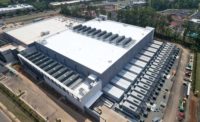 |
| SOFT CELL Changeable units provide a variety of training scenarios for first responders. (Image courtesy of Mike Williams/URS Corp.) |
Urban Search and Rescue Teams usually train in artificial situations. But thanks to construction industry volunteers, the Fairfax County, Va., Urban Search and Rescue Task Force will soon have a changeable "scenario building" where members can practice rescues in simulated collapsed structures or confined spaces.
About a year ago, task force member Leo Titus, a geotechnical engineer with ECS Ltd., Chantilly, Va., reached out to the construction community to help the squad realize its dream of a unique training facility. Fairfax task force members responded to the Sept. 11, 2001, attacks on the World Trade Center and Pentagon, 1999 earthquakes in Turkey and 1995 Oklahoma City blast.
 |
| STANDING TALL ABC members donated time and materials. (Photo by Dean Tills) |
With an $800,000 structure in mind, but with no cash on hand, Titus approached the Virginia chapter of the Associated Builders and Contractors for help. ABCs community service committee endorsed the project. Its members soon were donating materials, labor and services to build the three-story, 5,000-sq-ft, slab-on-grade concrete block training center that is set to open this month.
The structures flexibility is key. A typical, fixed-layout training building quickly becomes familiar to rescuers, lessening the impact of training, says Dean J. Tills, the task forces structural engineer section leader. This building allows new twists and snags, creating better training, he says. Tills is a principal with San Francisco-based URS, which provided the design.
Mike Cantrall, senior vice president with Bethesda, Md.-based contractor Miller & Long Co. Inc., served as the concrete subcontractor. "It was fairly easy to engender enthusiasm," he says.
|
Each floor is divided into four cells where different scenarios can be created. Inside are anchors for hanging or sloping floors and knock-out panels for practicing breaking or breaching concrete and steel, says Tills. Trainees also can rappel a four-story enclosed shaft in an environment similar to a below-grade subway station.
Crane operators can lift the roof in three pieces. A tunnel will run beneath the site. Each cell is accessed through a roll-up door, making interior structural changes easier. Training can take place in small sections or through the entire building.
With no finishes, it looks like a bombed-out building, says Patrick Dean, president of ABC Virginia. But he is proud that members have "built something that benefits the community and highlights the industry."
click below to view more articles from this special report >>
Overview
Hazardous Materials
Infrastructure
Rehabilitation
Water Supply
Lessons from Israel
Security Products

